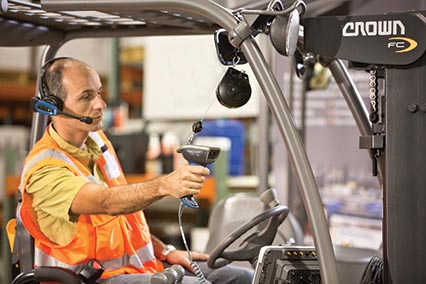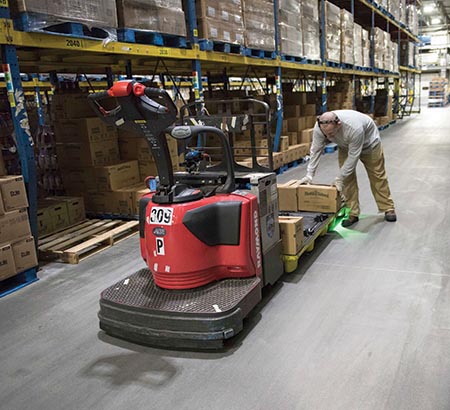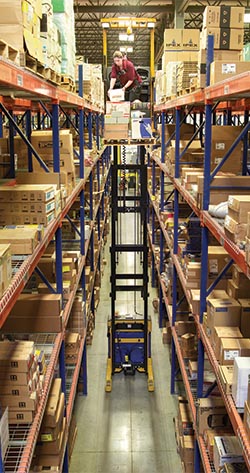Lift Truck Series Part 1: Lift truck technology connects pickers to productivity
Mobile, connected and critical to the movement of goods, the modern lift truck and picker are helping unlock the next level of productivity.

In our December issue’s lift truck story, Modern explored the growth of semi-autonomous technologies, from pallets jacks an operator can control at a distance to self-driving equipment fully integrated into warehouse systems. That story’s focus was how lift truck hardware is evolving to support safety and efficiency.
This time, we’ll focus on the picker, and how the connected nature of the modern warehouse supports productivity. In some ways, this is a drill-down that touches on components like mobile and wearable technology, lift truck telematics and battery management. However, the common theme of connectivity is the evolving role of the lift truck and its operator in the entire organization’s supply chain.
“Five years ago, nobody cared. A pallet jack is a pallet jack, and you drive it until it falls apart,” says Keith Phillips, president and chief executive officer of Voxware. “Now you have to think about how to make every device as effective as possible and tie them together to get a cohesive process, move products and manage your operations at the highest possible level of efficiency. All assets in the supply chain—pallet jack, trailer, handset, headset—are all worthless in today’s world without the technology to make them intelligent. If you don’t have that, then you can line up behind the Sports Authority stores of the world since you will quickly follow them.”
Sports Authority, sold to a private equity firm for $1.4 billion in 2006, filed for Chapter 11 Bankruptcy in 2016. It’s not the only casualty of the e-commerce boom, and it’s not just e-commerce that keeps managers up at night.
“A senior executive at one of our customers said they waited too long to make decisions on implementing technology, and now they can’t get orders out the door,” Phillips says. “Even the CEO and the whole executive team were in the warehouse picking into the night. You can’t throw people at the problem anymore. Technology is the only answer, and I think everybody should be looking.”
Room to lift productivity
The labor shortage isn’t going away any time soon, and we can count on rigorous customer demands. What is changing is the way providers of equipment and solutions work with customers and each another to achieve a whole that is greater than the sum of the parts. The lift truck, no longer just “steel and wheels,” is at the crossroads of the industry’s efforts to leverage technology and bring operational efficiency to the next level.
“I like to think of a lift truck as a mobile data collection tool, since most other systems are fairly static,” says Shelley Bell, industry manager for Yale Materials Handling Corp. “A forklift has the ability to tie a lot of processes together because it is mobile and interfaces with so many systems and equipment.”
This is true for lift trucks from $5,000 to $50,000, although many forklift users are unfamiliar with the rich data within their reach. Sue Rice, product manager for pallet trucks and stackers for The Raymond Corp., says the past few years have been an exercise in education for her and Raymond’s customers. Historically, a product manager of a pallet truck would be focused only on the truck itself, she says, but more customers are pushing for better solutions. Order picking is a particular focus, she adds, since the constant churn of materials’ receipt, putaway and retrieval can be 45% to 55% of operating costs.
“So many customers talk about the number of unfilled positions, so they want to get more productivity out of existing staff, improve accuracy and shorten the training curve,” Rice says. “That led us to a new focus, to integrate the pallet truck with other forms of technology.”
One especially creative customer approached Raymond with a concept born from the need to improve the accuracy of batch picking to double pallet trucks. Picking two orders at a time doubles the risk of error, so the company had already deployed voice-directed picking systems to boost accuracy and productivity.
 “Then they had the idea to embed lights into the forks of the trucks,” Rice says. “It was such a simple concept that we all wondered why nobody had tried it before.”
“Then they had the idea to embed lights into the forks of the trucks,” Rice says. “It was such a simple concept that we all wondered why nobody had tried it before.”
To be fair, the idea could probably only emerge in the modern technological environment. The colored LEDs embedded in the forks can connect to voice systems by Bluetooth, serial or Wi-Fi, and are thereby communicating directly with the warehouse management system (WMS). That’s right: Your WMS can talk to pickers through the forks of a pallet truck.
As the WMS directs the worker to a location, it will activate the light beneath the correct pallet. Using existing voice commands, there is no need to modify code or otherwise integrate the systems. Raymond’s customer and product development partner has since deployed the solution on 130 pallet trucks. A field test reported an initial 25% pick error reduction, which quickly grew to 35%. Another customer changed from single to double pallet trucks and saw a 40% productivity gain. The LED system even works for triple-length forks.
The sound of guidance
Rice estimates less than one in five warehouses are using radio frequency (RF) or voice picking systems, and the remainder is still paper-based. Many in the latter category assume only bigger fleets can get a comfortable return on investment.
“I’ve heard from voice providers that as small as five to 10 trucks can be a good fit,” she says. “Of course the more units, the quicker the payback, but it’s worth investigating if you’re unsure.”
Rice notes interest in voice coming from a spectrum of industries, including third-party logistics, consumer, food, healthcare and more. Some interested customers might believe a legacy WMS inhibits their ability to digitize directed processes. Ron Kubera, executive vice president and chief marketing officer at Lucas Systems, suggests customers think of voice as a mobile work execution system that complements the WMS. By putting a device in the hands of every operator and on every lift truck, companies can gain real-time visibility into what is happening.
Voxware’s Phillips notes that predictive and prescriptive analytics are critical to modern operations. “It’s no longer good enough to do the work and then look back to make corrections,” he says. “You have to correct in advance since the tolerance for mistakes is non-existent, whether shipping direct-to-consumer or to a store.”
As such, a voice system in itself is not the gatekeeper of productivity any more than a pallet truck is. Kubera says the real results come from harmonizing every element of technology and equipment around the picker.
“A pure voice pick initiative is a small percentage of overall savings, which come from re-engineering the process,” he says. “How can you achieve better density, dynamically optimize pick paths, and improve each business process? By integrating with lift trucks and all kinds of other DC technologies, there’s such a wealth of opportunity that it’s a very unique time.”
Kubera describes a customer who sought to reduce travel time by batch picking slow-movers and creating a merge area. It increased labor costs to merge, he says, but dramatically reduced labor in the overall process.
Top to bottom, end to end
Gaining a complete, overall view of the fleet’s impact on related processes is not simple, but all the tools are available. Marvin Logan, director of consulting services for Bastian Solutions, which was recently acquired by Toyota Industries Corp. as part of its new business division Toyota Advanced Logistics Solutions, says Bastian has since conducted research on the market interest for smarter lift trucks, telematics and tools that monitor the location and activity of equipment and operators to enhance safety and productivity.
 “There is an interest in capturing more data and tying the lift truck into engineered labor standards (ELS) with regard to things like best path, idle time and battery-changing time,” Logan says. “The capability has been out there for a while, but real-time tracking can help reduce dead-heading and support task interleaving. The lift truck is really just a commodity, but it can become a vehicle for wider improvements by adding these capabilities.”
“There is an interest in capturing more data and tying the lift truck into engineered labor standards (ELS) with regard to things like best path, idle time and battery-changing time,” Logan says. “The capability has been out there for a while, but real-time tracking can help reduce dead-heading and support task interleaving. The lift truck is really just a commodity, but it can become a vehicle for wider improvements by adding these capabilities.”
There are now plentiful tools to gain visibility into batteries and how they are charged, changed, opportunity-charged or maintained. These tools have benefited from a general rise in usage of electric trucks and may even have contributed to some companies’ decisions to switch from propane to electric, according to Steve Abernethy, national account manager for UniCarriers Americas.
“Traditional telemetry systems give valuable data, but monitoring devices on both batteries and chargers provide a lot of eye-opening information that can help quantify utilization and productivity,” he says. “We have found several cases where the customer has more equipment than they need. Particularly in a leasing environment, where probably 80% under-utilize equipment.”
One manufacturing customer running three shifts six days a week sought to convert from propane to electric. After capturing true utilization, UniCarriers reported to the customer that it used each lift truck an average of 1,800 hours per year—on a 3,000-hour lease.
“They thought there was no way that was possible, there must be some mistake,” Abernethy recalls. “Everyone will tell you they run the wheels off them and use their equipment more than anyone else. When you can continuously collect data because of battery monitors and telemetry, you can’t hide from the details.”
Logan says the initial savings of such a project are one thing, but the real benefit is in how visibility supports continuous improvement.
“If I buy a lift truck and will need to improve costs by another 10% next year, I can collect the data to make that happen,” he says. “It’s the sophisticated customer who is forward-thinking enough to pursue tools that will give incremental year-over-year improvements. It’s not widely adopted, but there is more and more interest and the technology is just getting better and cheaper.”
Connected equals competitive
As the Internet of Things (IoT) continues to connect elements throughout the facility and supply chain, the lift truck is uniquely positioned to bridge a variety of gaps.
“What we don’t want to do is be a dark spot in IoT, which is what happens when you don’t have a smart lift truck,” Ball says. “Being a dark spot in the overall equation of the operation is not good. So everything is being designed with an open architecture model in mind, since we will have to interface with everything from the WMS to the transportation management system (TMS). If a truck in a trailer has GPS, for example, then you’re truly tracking every step in the supply chain. The only missing link then would be integration with the retail point-of-sale systems.”
 The nature of connected devices available to the picker and the retail store associate are also converging. Consumer-style devices and wearable technologies offer even more granularity to eliminate dark spots of data capture. Bruce Stubbs, director of supply chain marketing for Honeywell Safety and Productivity Solutions, predicts continued growth in the creative blending of technologies in the warehouse. An RF solution could be a handheld mobile computer, but it could also be a wearable, which is becoming very popular, Stubbs says. If the worker needs to scan a long alphanumeric serial number, that’s not easy with typing or even voice. But a wearable ring scanner, for example, can be used by itself, or voice by itself, or they can be combined to achieve the best possible output.
The nature of connected devices available to the picker and the retail store associate are also converging. Consumer-style devices and wearable technologies offer even more granularity to eliminate dark spots of data capture. Bruce Stubbs, director of supply chain marketing for Honeywell Safety and Productivity Solutions, predicts continued growth in the creative blending of technologies in the warehouse. An RF solution could be a handheld mobile computer, but it could also be a wearable, which is becoming very popular, Stubbs says. If the worker needs to scan a long alphanumeric serial number, that’s not easy with typing or even voice. But a wearable ring scanner, for example, can be used by itself, or voice by itself, or they can be combined to achieve the best possible output.
Stubbs is keeping an eye on head-worn wearables that could disrupt the entire mobile data capture landscape.
“When companies went away from paper, they saw big improvements, but they’re now looking for something to take it to the next level,” he says. “They’ve utilized what’s available to its best ability, but they need more as the cost of doing business rises and becomes more competitive. Savings in logistics can be just as impactful to bottom-line profit and loss as margins from sales in stores.”
The burgeoning head-worn wearable realm could combine vision, voice and scanning in one technology, he says. Imagine using your eyes to frame a bar code and using voice to scan. A worker can now communicate back and forth between the system without blackout periods when operating equipment. Whereas screens black out for safety when driving, other technologies can still provide directions, updates and more.
“These types of technologies are limitless in the doors they could open to greater productivity, ergonomics and safety,” Stubbs says. “The movement of goods is so critical to the success of the organization they don’t take a lot of risk. But scanning has been proven for decades, voice is now proven, and vision is being proven in other arenas that will shorten the curve of people wanting to jump on board.”
Bell suggests technology adoption will not be a matter of innovation, but of survival.
“Especially with e-commerce, you do not have the luxury to be inefficient, and the really successful operations need to pivot and shift,” she says. “It used to be ‘here’s the process, here are the confines of the work, and if doesn’t fit we’re not doing it.’ That’s not the reality anymore. If you’re going to remain profitable, it’s not enough just to adapt to demand, it’s about adapting to the type of demand. And if you feel things are going smoothly, you will likely be obsolete before too long.”

Article Topics
Latest in Logistics
LM reader survey drives home the ongoing rise of U.S.-Mexico cross-border trade and nearshoring activity A buying guide to outsourcing transportation management SKU vs. Item-level Data Visibility: Why it Matters for End-to-End Traceability Key benefits of being an Amazon Business customer with Business Prime USPS cites continued progress in fiscal second quarter earnings despite recording another net loss U.S. rail carload and intermodal volumes are mixed, for week ending May 4, reports AAR New Ryder analysis takes a close look at obstacles in converting to electric vehicles More LogisticsAbout the Author
Subscribe to Logistics Management Magazine

Find out what the world's most innovative companies are doing to improve productivity in their plants and distribution centers.
Start your FREE subscription today.
May 2024 Logistics Management

Latest Resources














